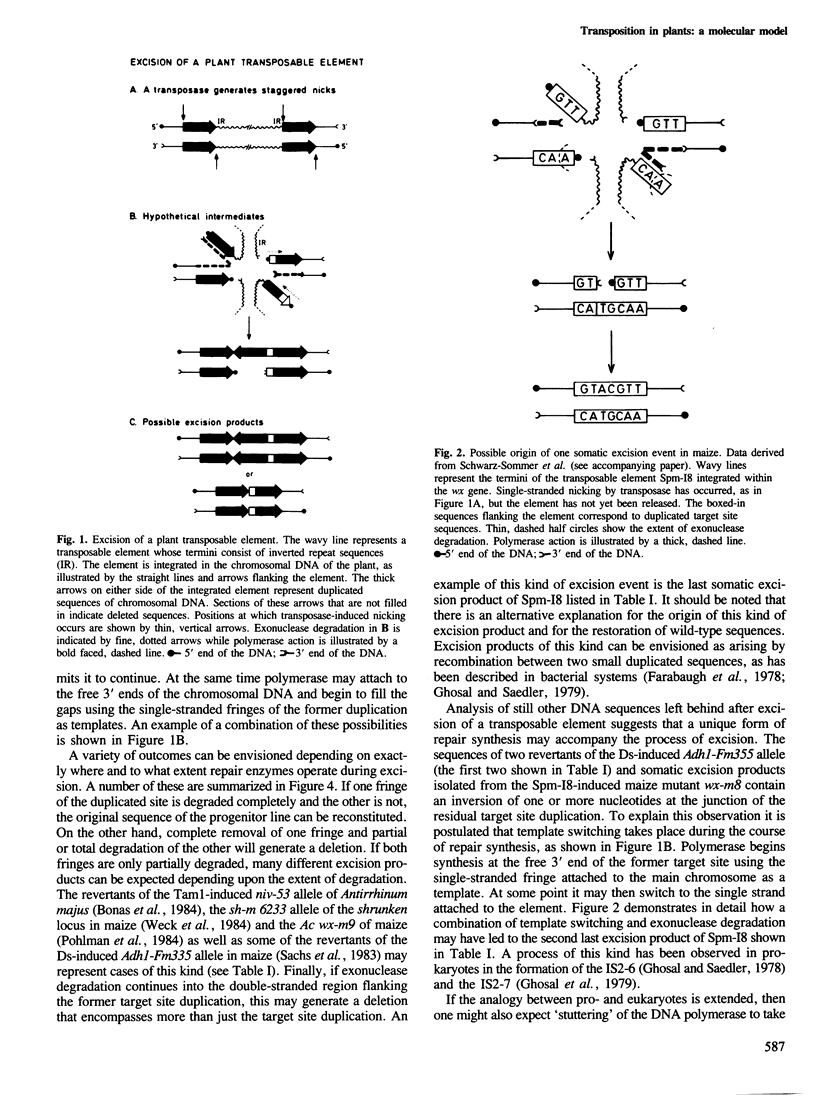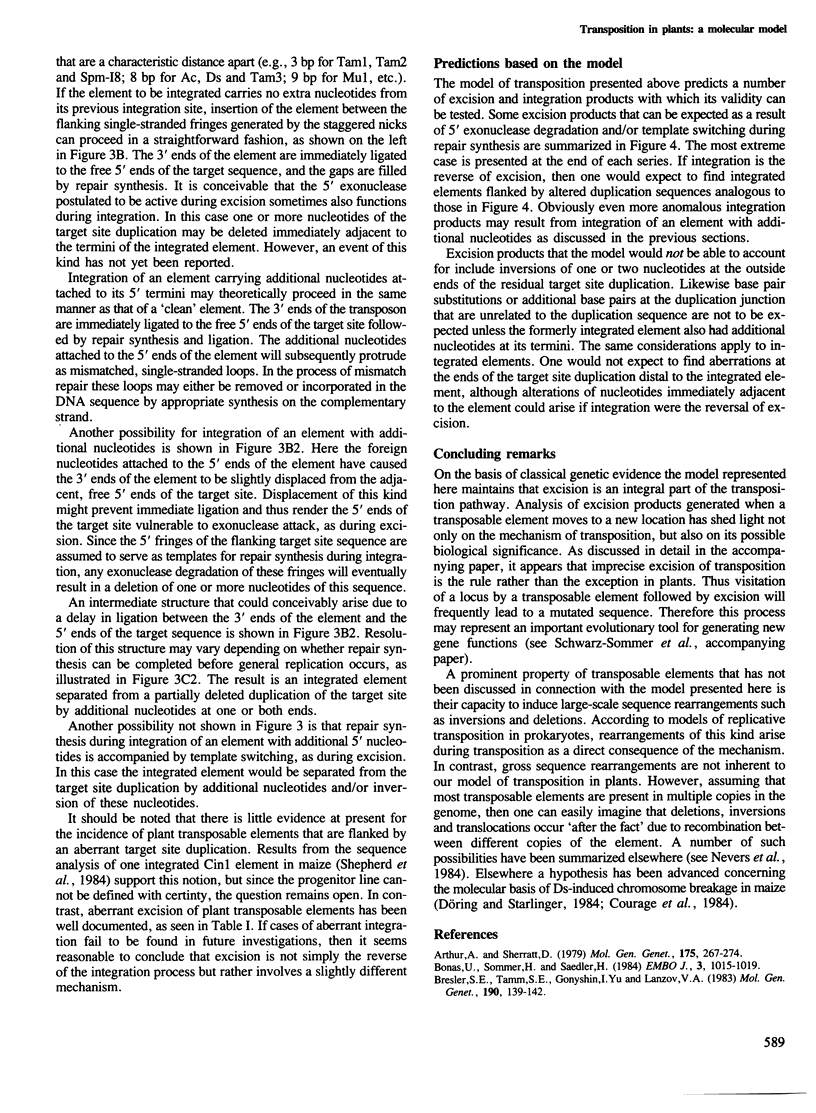Abstract
A molecular model for transposition of plant transposable elements is described. This process may occur via excision and re-integration of the element. Excision generates DNA sequence diversity which suggests the participation of DNA repair enzymes in the healing of the donor molecule.
Keywords: transposable element, excision, integration, DNA sequences
Full text
PDF





Selected References
These references are in PubMed. This may not be the complete list of references from this article.
- Arthur A., Sherratt D. Dissection of the transposition process: a transposon-encoded site-specific recombination system. Mol Gen Genet. 1979 Oct 1;175(3):267–274. doi: 10.1007/BF00397226. [DOI] [PubMed] [Google Scholar]
- Bonas U., Sommer H., Saedler H. The 17-kb Tam1 element of Antirrhinum majus induces a 3-bp duplication upon integration into the chalcone synthase gene. EMBO J. 1984 May;3(5):1015–1019. doi: 10.1002/j.1460-2075.1984.tb01921.x. [DOI] [PMC free article] [PubMed] [Google Scholar]
- Bresler S. E., Tamm S. E., Goryshin IYu, Lanzov V. A. Postexcision transposition of the transposon Tn10 in Escherichia coli K12. Mol Gen Genet. 1983;190(1):139–142. doi: 10.1007/BF00330336. [DOI] [PubMed] [Google Scholar]
- Brink R A, Nilan R A. The Relation between Light Variegated and Medium Variegated Pericarp in Maize. Genetics. 1952 Sep;37(5):519–544. doi: 10.1093/genetics/37.5.519. [DOI] [PMC free article] [PubMed] [Google Scholar]
- Döring H. P., Starlinger P. Barbara McClintock's controlling elements: now at the DNA level. Cell. 1984 Dec;39(2 Pt 1):253–259. doi: 10.1016/0092-8674(84)90002-3. [DOI] [PubMed] [Google Scholar]
- Farabaugh P. J., Schmeissner U., Hofer M., Miller J. H. Genetic studies of the lac repressor. VII. On the molecular nature of spontaneous hotspots in the lacI gene of Escherichia coli. J Mol Biol. 1978 Dec 25;126(4):847–857. doi: 10.1016/0022-2836(78)90023-2. [DOI] [PubMed] [Google Scholar]
- Fincham J. R., Sastry G. R. Controlling elements in maize. Annu Rev Genet. 1974;8:15–50. doi: 10.1146/annurev.ge.08.120174.000311. [DOI] [PubMed] [Google Scholar]
- Ghosal D., Gross J., Saedler H. DNA sequence of IS2--7 and generation of mini-insertions by replication of IS2 sequences. Cold Spring Harb Symp Quant Biol. 1979;43(Pt 2):1193–1196. doi: 10.1101/sqb.1979.043.01.135. [DOI] [PubMed] [Google Scholar]
- Ghosal D., Saedler H. DNA sequence of the mini-insertion IS2--6 and its relation to the sequence of IS2. Nature. 1978 Oct 19;275(5681):611–617. doi: 10.1038/275611a0. [DOI] [PubMed] [Google Scholar]
- Ghosal D., Saedler H. IS2-61 and IS2-611 arise by illegitimate recombination from IS2-6. Mol Gen Genet. 1979 Oct 3;176(2):233–238. doi: 10.1007/BF00273217. [DOI] [PubMed] [Google Scholar]
- Greenblatt I M, Brink R A. Twin Mutations in Medium Variegated Pericarp Maize. Genetics. 1962 Apr;47(4):489–501. doi: 10.1093/genetics/47.4.489. [DOI] [PMC free article] [PubMed] [Google Scholar]
- Greenblatt I. M. Movement of modulator in maize: a test of an hypothesis. Genetics. 1974 Aug;77(4):671–678. doi: 10.1093/genetics/77.4.671. [DOI] [PMC free article] [PubMed] [Google Scholar]
- Greenblatt I. M. The mechanism of modulator transposition in maize. Genetics. 1968 Apr;58(4):585–597. doi: 10.1093/genetics/58.4.585. [DOI] [PMC free article] [PubMed] [Google Scholar]
- Greenblatt I. M. Transposition and replication of modulator in maize. Genetics. 1966 Feb;53(2):361–369. doi: 10.1093/genetics/53.2.361. [DOI] [PMC free article] [PubMed] [Google Scholar]
- Nevers P., Saedler H. Transposable genetic elements as agents of gene instability and chromosomal rearrangements. Nature. 1977 Jul 14;268(5616):109–115. doi: 10.1038/268109a0. [DOI] [PubMed] [Google Scholar]
- Pohlman R. F., Fedoroff N. V., Messing J. The nucleotide sequence of the maize controlling element Activator. Cell. 1984 Jun;37(2):635–643. doi: 10.1016/0092-8674(84)90395-7. [DOI] [PubMed] [Google Scholar]
- Shapiro J. A. Molecular model for the transposition and replication of bacteriophage Mu and other transposable elements. Proc Natl Acad Sci U S A. 1979 Apr;76(4):1933–1937. doi: 10.1073/pnas.76.4.1933. [DOI] [PMC free article] [PubMed] [Google Scholar]
- Shepherd N. S., Schwarz-Sommer Z., Blumberg vel Spalve J., Gupta M., Wienand U., Saedler H. Similarity of the Cin1 repetitive family of Zea mays to eukaryotic transposable elements. Nature. 1984 Jan 12;307(5947):185–187. doi: 10.1038/307185a0. [DOI] [PubMed] [Google Scholar]
- Sommer H., Cullum J., Saedler H. IS2-43 and IS2-44: new alleles of the insertion sequence IS2 which have promoter activity. Mol Gen Genet. 1979 Aug;175(1):53–56. doi: 10.1007/BF00267855. [DOI] [PubMed] [Google Scholar]
- Sutton W. D., Gerlach W. L., Peacock W. J., Schwartz D. Molecular analysis of ds controlling element mutations at the adh1 locus of maize. Science. 1984 Mar 23;223(4642):1265–1268. doi: 10.1126/science.223.4642.1265. [DOI] [PubMed] [Google Scholar]
- Van Schaik N W, Brink R A. Transpositions of Modulator, a Component of the Variegated Pericarp Allele in Maize. Genetics. 1959 Jul;44(4):725–738. doi: 10.1093/genetics/44.4.725. [DOI] [PMC free article] [PubMed] [Google Scholar]
- Weck E., Courage U., Döring H. P., Fedoroff N., Starlinger P. Analysis of sh-m6233, a mutation induced by the transposable element Ds in the sucrose synthase gene of Zea mays. EMBO J. 1984 Aug;3(8):1713–1716. doi: 10.1002/j.1460-2075.1984.tb02036.x. [DOI] [PMC free article] [PubMed] [Google Scholar]


